Auschwitz and Cinema’s Depiction of the Holocaust
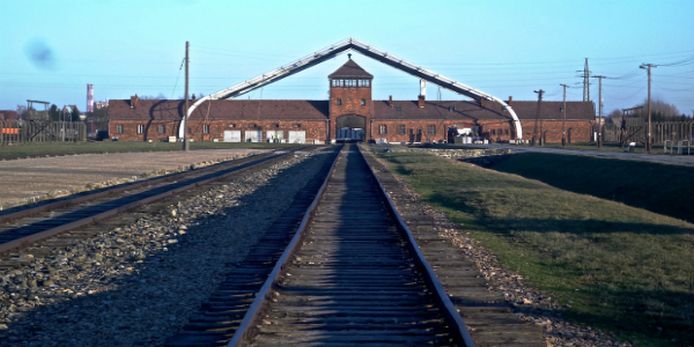
I'm a film buff from South East England. I run…
My visit to Auschwitz was more uncanny than overwhelming
As a child my eyes used to always glaze over when my father watched what he gleefully called ‘boring black and white documentaries’, it was all he ever put on the television. Despite this, I still had an interest in World War 2, it was the most pivotal moment of the 20th century and so many films have been influenced by the event, however the Vietnam War films of the 70’s and 80’s garnered most of my attention in my early teens. By my late teens however, I found my once average interest burgeoning to the point where I was the one incessantly watching the boring black and white documentaries.
The events of 1939-1945 may have been recorded in largely black and white, but they certainly weren’t boring, they were utterly unhinged and deranged. The most macabre deaths of the approximately 60 million that occurred during World War 2 were those of the Holocaust, the narrative of which beginning with thuggish persecution followed by foul ghettoisation and finally the industrial murder of millions that abruptly stopped once disgusted, incredulous Allied troops liberated the camps.
As I wrote in my review of Schindler’s List, the appalling scope of the Holocaust, also known as the Shoah (Hebrew for ‘the catastrophe’), is hard to comprehend objectively and even harder – nigh-on impossible – to process emotionally. To try and get a greater understanding of the Holocaust, both historical and emotional, I thought that there would be nothing more enlightening than visiting the ghoulish landmarks of the ‘Final Solution’.
There are many sites of Nazi atrocities that one could visit. There’s Treblinka in eastern Poland, a comparatively small camp that had the appearance of a remote railway station, however this was strictly a veneer, a cruel deception – beyond Treblinka’s flower pots and fake signage was a collection of barracks, gas chambers and pits spread over approximately 33-42 acres with the sole purpose of murder – an estimated 900,000 people were killed there, 99% were dead within two hours of arrival. The other camps within Poland that shared this purely fatal objective were Sobibór (200,000 – 250,000 dead), Bełżec (434,508 – 600,000 dead), Chełmno (152,000 – 340,000 dead), and Majdanek (78,000 dead).

Despite the massive numbers, none of these camps were the deadliest. It was the enormous Auschwitz complex that surpassed Treblinka’s crimes, causing the deaths of an estimated 1.5 million people, which is three times the population of Edinburgh. Auschwitz wasn’t merely a death camp, all manner of abuse and exploitation occurred – slave labour, starvation, murder and nightmarish medical experiments by sadistic perverts like Dr. Josef Mengele, AKA ‘Angel of Death’.
Built in and around the Polish town of Oświęcim, Auschwitz comprised 45 satellite camps and three main camps, which were: Auschwitz I, the original camp that evolved from a former Polish army barracks; Auschwitz II-Birkenau, a substantial concentration/extermination hybrid camp with five crematoriums and Auschwitz III – Monowitz, an enormous factory built for IG Farben, a chemical company who fully endorsed murderous slave labour and was a producer of Zyklon B, the cyanide-based pesticide that the SS realised the fatal potential of.
Auschwitz would be unlike anywhere I’d ever been, an appalling monument that would compel and disturb even those most indifferent about history. It may be a thousand miles from Britain but two return tickets to Krakow, Poland’s cultural capital, cost only £120 courtesy of RyanAir.
Krakow’s a great place to visit in early January

I had been to Krakow before in July 2012, it was amongst my favourite cities I visited during my month’s inter-railing. People laughed when I told them I was going to Poland in January and I understood why, however as we walked through the main square of Krakow’s Old Town in mild temperatures, Poland seemed not at all a strange pace to visit at that time of year. The city was even better than I remembered – with the imposing medieval architecture of St. Mary’s Basilica, the Barbican and Wawel Castle and the many stylish bars and restaurants such as Alchemia and The Piano Rouge, Krakow has all the earmarks of a European city break apart from the prices, the British Pound Sterling goes a long way!
Auschwitz I
Krakow and the surrounding area is of course also steeped in my main reason for visiting – history. As mentioned earlier, Auschwitz is situated in the rather unsightly Oświęcim, an industrial town about 40 miles west of Krakow. You’d think a 40 mile train journey would be quite swift, however our disconcertingly – sometimes terrifyingly – bumpy journey took about two hours. The train, which looked and certainly felt like it was created in the technologically dodgy communist years, also had a habit of obnoxiously jolting every time it pulled away from a station.
When we disembarked at Oświęcim, a ticket clerk pointed down a road adjacent to the railway station and told us that Auschwitz was only 1km away. Encouraged by this, we walked down a long featureless road, coming across some Brutalist carbuncles that could have been straight out of Kryzstof Kieslowski’s nihilistically depressing A Short Film About Killing (1984). Despite feeling we were on the road to nowhere, one of Oświęcim’s few sign posts for Auschwitz I & II reassured us that we weren’t, and eventually we stumbled upon Auschwitz I.
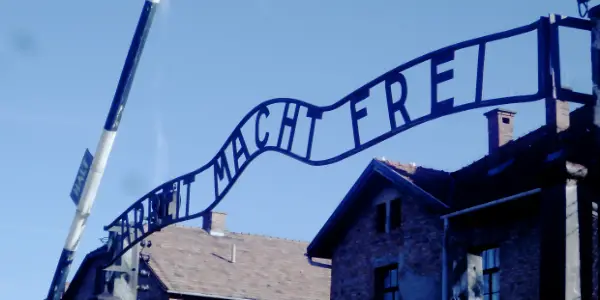
Auschwitz I, the camp whose gate infamously displays the cruel lie ‘Arbeit Mach Frei’ (work sets you free), is a veritable museum packed with information and requires many hours – perhaps a second a visit – to absorb it all. With the many displays bluntly informing you of the endless violence of the site, I couldn’t help feeling numb and oddly detached, I had only a few sensory instances during my visit. The most notable one occurred in the gas chamber of Auschwitz I.
Before entering there is a sign reading – ‘You are about to enter a room in which the SS murdered thousands of people, please behave with respect.’ This powerful statement was a stark reminder of the reality of this place, it filled me with a sense of dread as I walked alone through the doorway. I stood in the grey, dilapidated gas chamber and brief images appeared in my head of victims desperately piling on top of each other as they suffocated, an image that was planted in my mind by the eyewitness account of SS-Rottenführer Oskar Gröning in the comprehensive BBC series Auschwitz: Inside the Nazi State.
The room had an eerie, almost spectral atmosphere that made me rather anxious and unnerved; I was particularly disturbed when I noticed the scratch marks all over the walls, some of which having very distinct, tortured grooves.
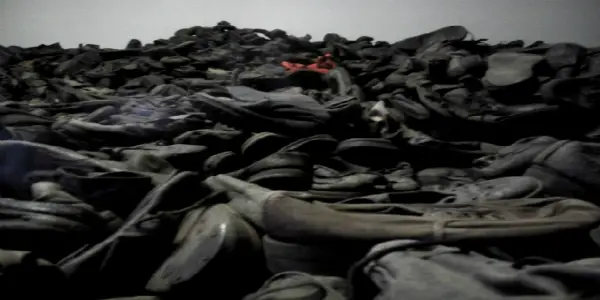
Also housed at Auschwitz I are the possessions pillaged from inmates. The images of eye glasses, clothes and shoes piled high have become infamous and emblematic of the sheer number of people who were abused and murdered. The photo my girlfriend took above came out looking rather like the ‘red girl’ sequence in Schindler’s List.
Auschwitz II – Birkenau
Keen to make it to Auschwitz Birkenau before sundown, we left the first camp after two hours and walked down yet another long, straight road with aching feet until it felt like the wrong way, so I stood and scanned the barren horizon of flat, grey buildings and dead, plastic bag-adorned trees. This felt futile until a familiar shape in the distance caught my eye, when I focused in on it I realised it was Birkenau’s infamous watchtower and that the road we were currently on wasn’t leading to it. Forced by Oświęcim’s inadequate sign postage, we used this imposing structure as a navigational beacon, eventually following the road towards the tower’s ‘gate of death’.

As we neared the site I found its positioning odd, you walk through a series of quiet, unassuming house-lined streets until you are greeted by the gate tower. I didn’t expect this death camp, perhaps the most awful place in history, to be on the edge of a sleepy suburban development – it must have a negative effect on house prices, surely?
The gate tower is an icon of mass murder that’s familiar to anyone with an awareness of Nazi genocide. I had eagerly awaited my first proper glimpse of it, however I was rather distracted by the workmen who were, as you can see from my generic photographs, erecting an enormous marquee over the main building. This, I was informed, would be part of the 70th anniversary event. I thought the construction of another memorial to be rather superfluous, not only is the original complex enough of a memorial but there’s also a huge (and not very good) concrete memorial situated between crematoria 3 & 4 on the western perimeter of the camp.
However, I have now seen the uncanny and striking result of all those cranes, tractors, pillars and churned up mud. As the photo from The Telegraph coverage below illustrates, the marquee envelops the ‘gate of death’ and makes it an indoor object, it’s very curious to look at, it doesn’t look real. However, after watching the news coverage of the event I now have a new objection – Samuel Barber’s Adagio for Strings is a very moving piece of music, but I consider playing it on loud speakers whilst candles are laid on the memorial to be cheap sentimentalism, its presence is unnecessary in a place like Auschwitz, all it achieves is reminding me of Oliver Stone’s rather melodramatic Platoon (1986).
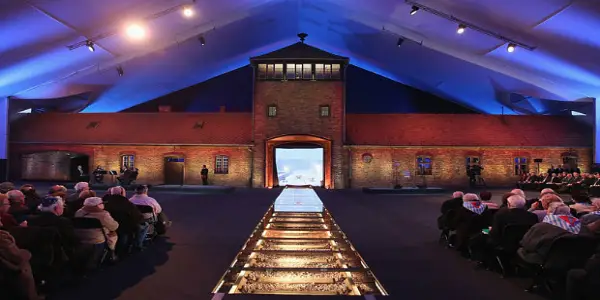
Thankfully, the disruption didn’t go beyond the camp’s entrance. I was immediately struck by the silence in the grounds, it’s difficult to estimate how many people were there owing to the Birkenau’s considerable 425 acre size. However, when we arrived at about 3 pm, there must have been no more than fifty other people touring the site. Because of this, walking around Auschwitz can be a surprisingly private experience; indeed, as we made our way to the exit as the evening grew darker and colder, I’m fairly sure we were the only tourists left. That was another odd, sensory moment, my girlfriend and I being the only people present at such a notorious institution that hosted so many people and so much cruelty.
My feelings were much the same in Auschwitz Birkenau as they had been in Auschwitz I. I had read that it was an ‘overwhelming’ experience, and I suppose that is an accurate description, however my reaction to this overwhelment wasn’t an emotional breakdown but rather a numb detachment that was punctuated by an occasional portent feeling and this nervous unease that put the hairs on the back of my neck on end. I’d get this latter sensation when I peeked into the windows of locked barracks; in most instances the rooms were dark, dusty and dilapidated, yet having some knowledge of what happened in these nondescript old wrecks made me feel somewhat spooked as if some tortured soul’s face was suddenly going to appear in the shadows.
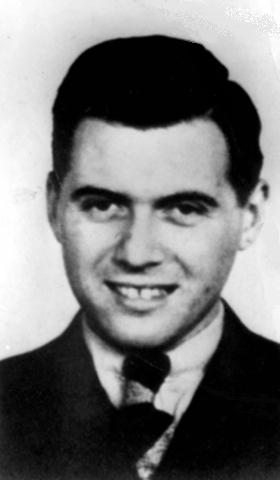
A display had informed me that one particular barracks I was trepidatiously peering into had seen scores of executions, the method of which being a lethal injection of phenol directly into the heart. Although other doctors also operated at Auschwitz, it was the aforementioned Josef Mengele (pictured right) whose sadism truly knew no bounds, he was a serial killer allowed to act with total impunity. I toured rooms in which attempts had been made to change victims’ eye colour through chemical injections into the eyeball and also blood type alterations that left victims either dead or wrought with illness. Since my trip I have read survivor Vera Alexander‘s account of how Mengele sewed Romani twins together in an attempt to create conjoined twins, they died of gangrene after a few days’ suffering of unimaginable magnitude.
Although Auschwitz I had information in abundance, I consider it more a landmark than a museum. To my surprise, the best museum I visited in Krakow was Oskar Schindler’s former enamelware factory. The building has been transformed into a multimedia exhibition that excellently compiles and presents the history of Poland’s tortured experiences during the war. Unlike many museums, the carefully planned exhibit succeeds in engaging both your intellect and emotions.
Is film an appropriate medium for the Holocaust?
With the Holocaust being such a sensitive subject, I have considered the ethics of dramatisation, whether it is appropriate and how it affects people’s understanding. I wrote the following in my review of Schindler’s List –
‘WWII and the Holocaust were events of mind bending statistics and proportions… the European and Pacific theatres were so dreadful, so massive, that it’s impossible for one to fully process it emotionally. Schindler’s List is one of the finest cinematic depictions of those dark years; a sweeping, brutal film that brings a remarkable story to the attention of millions of viewers. However, as with all historical films, it does not serve as the definitive source of information.’
Whilst pontificating this matter I discovered the documentary Imaginary Witness: Hollywood and the Holocaust. Directed by Daniel Anker, Imaginary Witness explores the history of Hollywood’s different approaches to the deeply murky subject of the Holocaust, featuring a variety of films and interviewees such as Steven Spielberg, Sidney Lumet, Rod Steiger and many others.
During the documentary’s introduction, producer Martin Starger echoes my thoughts exactly –
‘It is impossible to do it total justice. It is impossible. You can never duplicate it, you can never deliver it so that the survivors will look at it and say ‘Yes, you’ve told the story accurately… that’s as bad as it was’ it’s never going to be as bad as it was, you can never portray it. The dilemma is – should you not do it?’
As producer of Holocaust drama Sophie’s Choice in 1982, it seems Starger thinks it should be done, and I do too, providing that the filmmakers have skill, nuance and a thorough understanding of the subject.
There have been numerous works of fiction that have furthered understanding and discourse. Perhaps the most recent example is The Pianist (2002), whose director Roman Polanski is more entitled than most to direct a film on the Holocaust, he can apply first-hand experience to such a project. The film depicts the remarkable true story of Polish pianist Wladyslaw Szpilman’s desperate fight for survival in the ruins of Warsaw; one feels almost as battered as the gaunt, skeletal Adrien Brody as he hobbles along with his hands wrapped firmly around a tin of pickles.
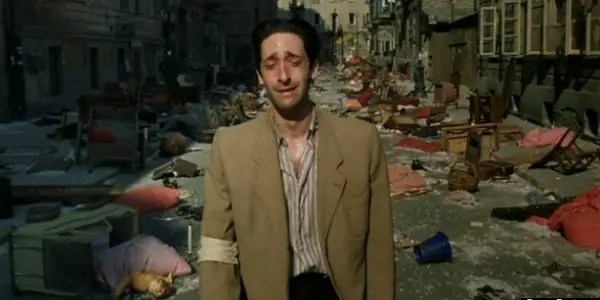
Polanski’s experiences during the war were much like Szpilman’s, both lost family members – Polanski his mother, Szpilman his entire family – and both endured and escaped ghettos – Polanski in Krakow, Szpilman in Warsaw. In episodes reminiscent of Jerzy Kosinki’s haunting novel The Painted Bird, the 10/11 year-old Polanski wandered around the Polish back country during what must have been a terrifying, confusing ordeal. During this period he stumbled upon Germans who gleefully shot at him for target practice. It is remarkable that Polanski, deemed by an entire state as ‘sub-human’ and escaping death so narrowly, would go from a refugee wandering the countryside with only the clothes on his back to being at the top of Hollywood around twenty-five years later.
Another notable installment in the Holocaust cinematic canon isn’t a film but the Emmy award-winning miniseries War and Remembrance (1988), which set a new benchmark in terms of the screen’s graphic depiction of history. Director Dan Curtis was intent on making the programme appropriately violent and disturbing –
‘In terms of the graphic intensity of what I showed, what we were doing was telling the story of the Holocaust, we have to show it… certainly we couldn’t show everything and certainly we couldn’t come close to what actually happened, but if we came reasonably close, we hopefully would accomplish our mission.’
Steven Spielberg supported Remembrance’s level of violence – ‘
It was very strong. I have never before or since seen anything like that… if it’s not done honestly, and honestly means graphically, it’s not going to seem any more or less violent than any scene from a John Wayne war movie.’
It’s interesting that Spielberg deemed Remembrance to be more disturbing than his film Schindler’s List, I think the utter off-handedness of List’s violence is a lot more shocking and realistic, I found some of Remembrance’s brutality somewhat staged and artificial.

Although it received much critical praise, War and Remembrance also faced criticism, particularly regarding the morality of the production. Some deemed the medium of television to be too light-weight for such a demonstrably heavy subject, and there was also understandable objection to the presence of advert breaks – it is perhaps a misjudgment that the high audience interest in this topic of massive human suffering was allowed to be used for commercial profit, television executives have had the good decorum to broadcast Schindler’s List without ad-breaks in the past.
However, film historian Sharon Rivo defends Remembrance, giving an insight into the programme’s effect –
‘I watched teenagers watch that programme and it had an enormous effect upon them. It was a new generation who in America had their first acquaintance with this horrendous topic.’
Curiously, dramatisations will often have a greater audience reach than a documentary. A well-crafted dramatic work is generally more likely to engage a viewer’s emotions, to cause them to invest their emotions into characters and therefore the subject of the Holocaust in a manner that’s perhaps more profound than some documentaries could achieve. Of course, there are many moving survivor accounts to be seen, heard, read, but it is cinema’s uncanny ability of bypassing one’s intellect and lending a degree of reality and authenticity to the events it’s so vividly depicting that proves most powerful for many viewers.
As I stated earlier, these films do not serve as the definitive sources of information. Many people realise this, they know that these films can only offer a grounding in the subject, so they seek greater insight by hearing the stories of those who were there. Steven Spielberg said –
‘I think survivors wanted to tell their stories when they felt there was an audience to receive the stories’.
Despite disparaging comments about how Schindler’s List is laced with sentimentality or that War and Remembrance is ‘soap opera-ish’ and commercialised, the film industry played a large part in constructing this audience, these mass-market productions have proven therapeutic and liberating for survivors who would have continued to suppress their tortured memories, telling not even friends and relatives let alone whole auditoriums of strangers. Furthermore, the creation of Schindler’s List also saw the creation of the Shoah Foundation, a non-profit organisation founded in 1994 by Spielberg that has a vast collection of 52,000 eyewitness testimonies and 109,687 hours of video footage as of February 2015.
In conclusion
Ultimately, when the Holocaust is concerned, I think cinema generally is a cause for good. It seems filmmakers have an utmost reverence for the subject and despite any flaws their well intentioned films may have, they succeed in popularising this area of history for every generation old enough to understand it. Auschwitz is an important place to visit, I found my reaction to it to be almost blunted, however, that may be because I already know at some length the ghastliness that occurred.
Those with a lesser interest may well be genuinely shocked and rattled by it, but I didn’t see anyone there who was in that state, their faces had the same blank, withdrawn and rather uncomfortable expression as mine, apart from one couple who took a selfie with beaming smiles under the gate of Auschwitz I as if it was the ‘haunted house’ at the local fairground.
One shouldn’t feel obliged to contrive outpourings of emotion, the level of suffering that happened there is completely and utterly removed from the vast majority of people’s lives, it’s difficult to empathise with such foreign experiences. Despite reaching this conclusion, I’m fairly certain I’ll visit Auschwitz again one day.
Do you think the dramatisation of the Holocaust is in poor taste? What do you think of the films mentioned in this article? Please have your say in the comment section below.
(top image: The ‘Death Gate’ at Auschwitz-Birkenau – photo: Jack Hawkins)
Does content like this matter to you?
Become a Member and support film journalism. Unlock access to all of Film Inquiry`s great articles. Join a community of like-minded readers who are passionate about cinema - get access to our private members Network, give back to independent filmmakers, and more.
I'm a film buff from South East England. I run Hawkensian.com, which comprises mostly film reviews but also various opinion pieces on history and politics.













